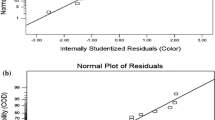Abstract
This study elucidates the reduction of Rhodamine B (RhB) color through electrochemical oxidation technique. Effects of current density, electrolyte type, electrolyte concentration, air flow rate and pH on the RhB color removal were investigated. The 24 full factorial design was used to investigate the individual and combined effects of the current density, NaCl concentration, air flow rate, and pH. Also, this study tested the reaction constant rate (k) regression models as an alternative response surface model for the optimization of operating conditions. Increase of pH decreased the RhB color removal efficiency. At the same time, the increase of current density, NaCl concentration, air flow rate also increased the RhB color removal efficiency. From the 24 factorial design, it was found that the individual main effects and four interaction effects (combined effects) of the independent variables were statistically significant (p<0.05). Also, the prediction results of the RhB concentration using the k regression models showed a nonlinear pattern which was similar to the actual experimental results. In the RhB color removal reactions, the 1st order k regression model showed a smaller prediction error than the 2nd order k regression model.
Similar content being viewed by others
References
L. Robert, H. M. Chiu, Sh. Ch. Shiau, R.Y. L. Yeh and Y. T. Hung, Dyes Pigm., 73, 1 (2007).
K. Rajeshwar and J.G. Ibanez, Environmental Electrochemistry. Fundamentals and application in pollution abatement, San Diego, CA, Academic Press (1997).
L. Szpyrkowicz, C. Juzzolino, S.N. Kaul, S. Daniele and M. D. De Faveri, Ind. Eng. Chem. Res., 39, 3241 (2000).
M. A. Sanroman, M. Pazos, M. T. Ricart and C. Cameselle, Chemosphere, 57, 233 (2004).
M. C. Rivera, M.M.D. Jimenez and M. P. E. Gonzalez, Chemosphere, 55, 1 (2004).
X. Chen, G. Chen and P. L. Yue, Chem. Eng. Sci., 58, 995 (2003).
A. Fernandes, A. Morao, M. Magrinho and I. Goncalves, Dyes Pigm., 61, 287 (2004).
S. H. Lin, C. F. Feng, Water Res., 28(2), 277 (1994).
U.B. Osutveren and S. Koparal, J. Environ. Sci. Health Environ. Sci. Eng., A29(1), 1 (1994).
K. Ravikumar, S. Ramalingam, S. Krishman and K. Balu, Dyes Pigm., 70, 18 (2006).
D.C. Montgomery, Design and analysis of experiments, 6th Ed., Wiley, New York, 405 (1991).
R. Krishna Prasad and S. N. Srivastava, Chem. Eng. J., 146, 22 (2009).
H. S. Fogler, Elements of chemical reaction engineering. Prentice-Hall, Englewood Cliffs, New Jersey, 179 (1986).
D. S. Kim and Y. S. Park, J. Environ. Sci., 18(11), 1235 (2009).
X.Y. Li, Y.H. Cui, Y. J. Feng, Z.M. Xie and J.D. Gu, Water Res., 39, 1972 (2005).
M. Li, C. Feng, W. Hu, Z. Zhang and N. Sugiura, J. Hazard Mater., 162, 455 (2009).
W. S. Cheng and J. S. Liang, J. Hazard Mater., 161, 1017 (2009).
M. Sudoh, H. Kitaguchi and K. Koide, J. Chem. Eng. Jpn., 18, 409 (1985).
K.V. Radha, V. Sridevi and K. Kalaivani, Bioresour. Technol., 100, 987 (2009).
Author information
Authors and Affiliations
Corresponding author
Rights and permissions
About this article
Cite this article
Song, Y., Kim, D. & Park, Y. Statistical optimization of Rhodamine B removal by factorial design using reaction rate constant in electrochemical reaction. Korean J. Chem. Eng. 28, 156–163 (2011). https://doi.org/10.1007/s11814-010-0361-x
Received:
Accepted:
Published:
Issue Date:
DOI: https://doi.org/10.1007/s11814-010-0361-x




